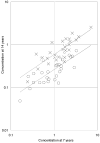Elimination half-lives of polychlorinated biphenyl congeners in children
- PMID: 18853821
- PMCID: PMC2600453
- DOI: 10.1021/es800778q
Elimination half-lives of polychlorinated biphenyl congeners in children
Abstract
The elimination kinetics of polychlorinated biphenyls (PCBs) in humans is difficult to assess in observational studies, because PCB exposure is never completely abolished. In a community with high dietary PCB exposures from whale blubber, we examined two groups of children with increased body burdens from breast-feeding. Follow-up was from ages 4.5 to 7.5 years (99 subjects) and 7 to 14 years (101 subjects). The calculations were performed by the use of structural equation models, with adjustment for body weight and dietary blubber intake as the main source of postnatal exposure. As a likely result of background exposures, apparent elimination half-lives were unexpectedly long when based on results from all cohort members. Subjects with exposures above the median and in the highest quartile showed half-lives of about 3-4 years for CB-138 and 4.5-5.5 years for CB-105 and CB-118; 6.5-7.5 years for CB-156, CB-170, and CB-187; and 7-9 years for CB-153 and CB-180. The longest half-lives correspond to elimination of the parent PCB solely with a daily fat excretion rate of 1-2 g, whereas shorter half-lives assume metabolic break-down.
Figures

Similar articles
-
Intrinsic human elimination half-lives of polychlorinated biphenyls derived from the temporal evolution of cross-sectional biomonitoring data from the United Kingdom.Environ Health Perspect. 2011 Feb;119(2):225-31. doi: 10.1289/ehp.1002211. Epub 2010 Oct 7. Environ Health Perspect. 2011. PMID: 20934951 Free PMC article.
-
Hydroxylated and methylsulfone-containing metabolites of polychlorinated biphenyls in the plasma and blubber of bowhead whales (Balaena mysticetus).Environ Toxicol Chem. 2003 Nov;22(11):2650-8. doi: 10.1897/02-641. Environ Toxicol Chem. 2003. PMID: 14587904
-
Health implications for Faroe islanders of heavy metals and PCBs from pilot whales.Sci Total Environ. 1996 Jul 16;186(1-2):141-8. doi: 10.1016/0048-9697(96)05094-2. Sci Total Environ. 1996. PMID: 8685706 Review.
-
Estimating plasma half-lives of dioxin like and non-dioxin like polychlorinated biphenyls after occupational exposure in the German HELPcB cohort.Int J Hyg Environ Health. 2021 Mar;232:113667. doi: 10.1016/j.ijheh.2020.113667. Epub 2020 Dec 9. Int J Hyg Environ Health. 2021. PMID: 33307299
-
Environmental exposure to polychlorinated biphenyls (PCBs) and dioxins. Consequences for longterm neurological and cognitive development of the child lactation.Adv Exp Med Biol. 2000;478:271-87. Adv Exp Med Biol. 2000. PMID: 11065080 Review.
Cited by
-
Polychlorinated biphenyls induce oxidative stress and metabolic responses in astrocytes.Neurotoxicology. 2021 Sep;86:59-68. doi: 10.1016/j.neuro.2021.07.001. Epub 2021 Jul 12. Neurotoxicology. 2021. PMID: 34265337 Free PMC article.
-
A nested case-control study of intrauterine exposure to persistent organochlorine pollutants in relation to risk of type 1 diabetes.PLoS One. 2010 Jun 23;5(6):e11281. doi: 10.1371/journal.pone.0011281. PLoS One. 2010. PMID: 20585661 Free PMC article.
-
Quantification of persistent organic pollutants in breastmilk and estimated infant intake, Norway.Matern Child Nutr. 2025 Jan;21(1):e13759. doi: 10.1111/mcn.13759. Epub 2024 Nov 5. Matern Child Nutr. 2025. PMID: 39501670 Free PMC article.
-
Exposure to p,p'-DDE: a risk factor for type 2 diabetes.PLoS One. 2009 Oct 19;4(10):e7503. doi: 10.1371/journal.pone.0007503. PLoS One. 2009. PMID: 19838294 Free PMC article.
-
Biomonitoring and Elimination of Perfluorinated Compounds and Polychlorinated Biphenyls through Perspiration: Blood, Urine, and Sweat Study.ISRN Toxicol. 2013 Sep 3;2013:483832. doi: 10.1155/2013/483832. eCollection 2013. ISRN Toxicol. 2013. PMID: 24083032 Free PMC article.
References
-
- Shirai JH, Kissel JC. Uncertainty in estimated half-lives of PCBS in humans: impact on exposure assessment. Sci. Total Environ. 1996;187:199–210. - PubMed
-
- Lotti M. Pharmacokinetics and blood levels of polychlorinated biphenyls. Toxicol. Rev. 2003;22:203–215. - PubMed
-
- Matthews HB, Anderson MW. The distribution and excretion of 2,4,5,2',5'-pentachlorobiphenyl in the rat. Drug Metab. Dispos. 1975;3:211–219. - PubMed
-
- Mes J, Arnold DL, Bryce F. The elimination and estimated half-lives of specific polychlorinated biphenyl congeners from the blood of female monkeys after discontinuation of daily dosing with Aroclor 1254. Chemosphere. 1995;30:789–800. - PubMed
-
- Öberg M, Sjödin A, Casabona H, Nordgren I, Klasson-Wehler E, Hakansson H. Tissue distribution and half-lives of individual polychlorinated biphenyls and serum levels of 4-hydroxy-2,3,3',4',5-pentachlorobiphenyl in the rat. Toxicol. Sci. 2002;70:171–182. - PubMed
Publication types
MeSH terms
Substances
Grants and funding
LinkOut - more resources
Full Text Sources
Research Materials

